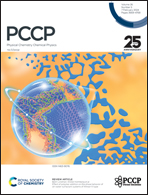Ion mobility calculations of flexible all-atom systems at arbitrary fields using two-temperature theory†
Abstract
Ion mobility spectrometry (IMS) separates and analyzes ions based on their mobility in a gas under an electric field. When the field is increased, the mobility varies in a complex way that depends on the relative velocity between gas and ion, their electrostatic potential interactions, and the effects from direct impingement. Recently, the two-temperature theory, primarily developed for monoatomic ions in monoatomic gases, has been extended to study mobilities at arbitrary fields using polyatomic ions in polyatomic gases, with some success. However, this extension poses challenges, such as inelastic collisions between gas and ion and structural modifications of ions as they heat up. These challenges become significant when working with diatomic gases and flexible molecules. In a previous study, experimental mobilities of tetraalkylammonium salts were obtained using a FAIMS instrument, showing satisfactory agreement with numerical two-temperature theory predictions. However, deviations occurred at fields greater than 100 Td. To address this issue, this paper introduces a modified high-field calculation method that accounts for the structural changes in ions due to field heating. The study focuses on tetraheptylammonium (THA+), tetradecylammonium (TDA+), and tetradodecylammonium (TDDA+) salts. Molecular structures were generated at various temperatures using MM2 forcefield. The mobility was calculated using IMoS 1.13 with two-temperature trajectory method calculations up to the fourth approximation. Multiple effective temperatures were considered, and a linear weighing system was used to create mobility vs. reduced field strength plots. The results suggest that the structural enlargement due to ion heating plays a significant role in mobility at high fields, aligning better with experimental data. FAIMS’ dispersion plots also show improved agreement with experimental results. However, the contribution of inelastic collisions and energy transfer to rotational degrees of freedom in gas molecules remains a complex and challenging aspect.



 Please wait while we load your content...
Please wait while we load your content...